Japan Wood Products
Prices
Dollar Exchange Rates of
10th March 2014
Japan Yen 103.28
Reports From Japan
National debt continues to expand
Japan's economy grew by 0.7% in 2013, down from an
initial estimate of 1%, being dragged down by lower than
forecast capital expenditure and a dip in consumer
spending.
Some economists doubt that either business investment or
consumer spending will recover quickly after the April tax
increase. The recent improvement in growth, say analysts,
is mostly the result of households rushing to buy cars,
electronics and other expensive items before the tax
increase.
Despite the growing debt the Bank of Japan (BoJ) is still
maintaining the economy will continue in a recovery mode
by the third quarter of this year and that 2014 will also see
positive growth.
Even with the downward revision in GDP the 2013
economic performance was still the best in three years.
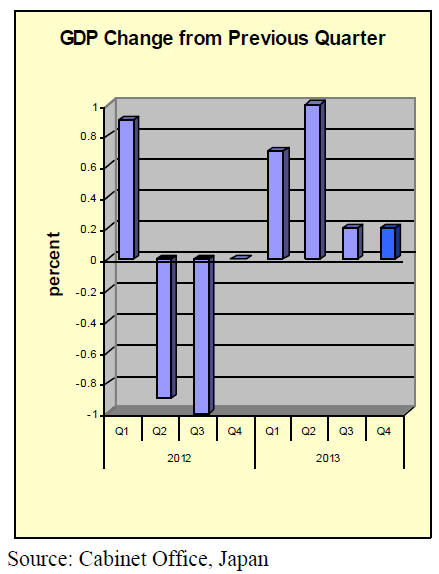
BoJ – No need to adjust stimulus measures
The BoJ has reiterated it will continue with its monetary
stimulus programme as, in its view, both the economy and
consumer sentiment are on track.
At its latest meeting the BoJ decided there was no need to
amend the monetary policy, saying the recent fall in
exports is temporary, the result of a slowdown in demand
from China and other emerging markets. The firm stance
by the BoJ pushed up the yen against the US dollar.
The bank appears confident that, because businesses are
pouring into new plant growth, will be generated. Recent
data showed industrial production rose 4% in January, the
second month increase in April.
In a statement the BoJ said: “With regard to the outlook,
Japan's economy is expected to continue a moderate
recovery as a trend, while it will be affected by the frontloaded
increase and subsequent decline in demand prior to
and after the consumption tax hike.
Exports are expected to increase moderately mainly
against the background of the recovery in overseas
economies.
As for domestic demand, public investment is expected to
trend upward for the time being and then become more or
less flat at a high level. Business fixed investment is
projected to follow a moderate increasing. Private
consumption and housing trend as corporate profits
continue to improve. Investment, albeit with some
fluctuations, are expected to remain resilient as a trend.”
For the full statement see:
https://www.boj.or.jp/en/mopo/gp_2014/gp1403a.pdf
Consumer confidence lowest for years in Japan
Japan‟s Cabinet Office has released the results of the
February 2014 Consumer Confidence Survey showing the
consumer confidence index fell to 38.3, the third month of
decline and the lowest it has been since September 2011.
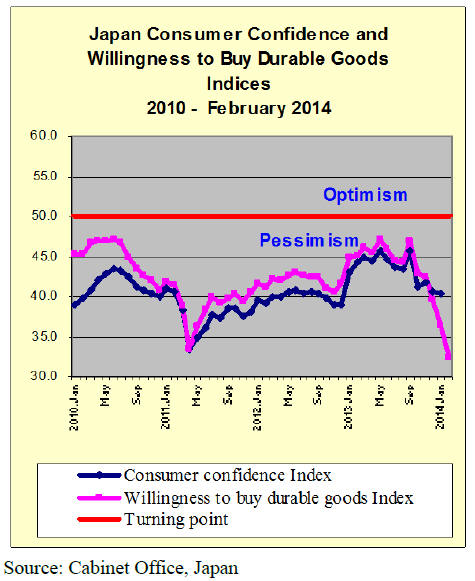
The latest survey was carried out on 15 February and
covered some 5,635 households (a 67% response rate) was
released on 12 March.
This survey shows more Japanese have become
pessimistic on the four main issues surveyed; overall
economic well-being, income growth, employment and
whether it is a good time to buy durable goods.
See: http://www.esri.cao.go.jp/en/stat/shouhi/shouhie.
html
The overall negative result of the survey prompted the
government to downgrade its assessment, saying,
"consumer confidence is weaker." Last month it said
confidence was "marking time."
Most analysts say consumer confidence is falling as
consumers worry the upcoming tax increase will be hard
to bear, especially as basic pay levels have been stagnant
for years and inflation seems set to rise.
During the latest round of wage negotiations the major
companies have been pushed by the government to raise
basic wages.
The proposed wage increases of between yen 2-3,000 per
month have been well received by workers and may result
in an improvement in the consumer confidence index for
March.
January housing starts fail to meet expectations
Despite a year on year 12% growth in January housing
starts, January 2014 starts, at 77,800, were down 13%
from levels a month earlier and below analysts
expectations.
The complete data set of housing starts can be found at the
Ministry of Land, Infrastructure, Transport and Tourism
website.
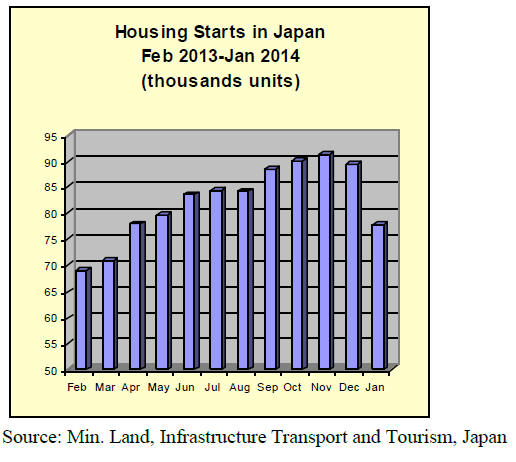
Despite the lower than expected January starts
construction companies report that orders increased by
around 15% year-on-year in January, the best result since
November 2013.
Yen strengthens as money moves out of China
In early March the yen strengthened against the US dollar
despite the drastic downward revision of fourth quarter
growth in GDP and a bigger than wider than expected
current account deficit for January.
The main cause of this strengthening, say analyst, was the
weaker than expected output data from China.
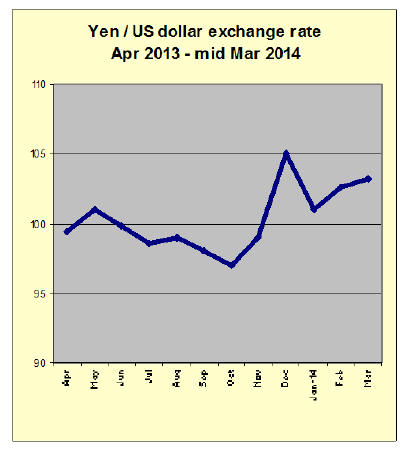
Large Japanese corporations posted high levels of profits
last year and 2013 was the best year for many of the large
corporations since 2007. However, almost all of the gains
were due to the depreciation of the yen against major
currencies which boosted Japan‟s export earning.
However, data suggests few companies actually shipped
more goods in 2013 but gained because more yen was
earned.
The ultra-loose monetary policy of the government
continues to hold down the exchange rate of the yen which
has fallen 24% against the US dollar since the current
government came into power.
Analysts estimate that, for Japanese manufacturers and
exporters, up to 80% of the rise in profits last year can be
explained by the yen:US dollar exchange rate change.
Trade news from the Japan Lumber Reports (JLR)
The Japan Lumber Reports (JLR), a subscription trade
journal published every two weeks in English, is
generously allowing the ITTO Tropical Timber Market
Report to extract and reproduce news on the Japanese
market.
The JLR requires that ITTO reproduces newsworthy text
exactly as it appears in their publication.
For the JLR report please see:
http://www.nmokuzai.
com/modules/general/index.php?id=7
Robust demand for New Zealand logs by China
Chinese purchase of New Zealand radiate pine logs had
kept growing until 2011 when the Chinese government
took tight money policy. The volume of import plunged all
of a sudden but since second half of 2012, the import
recovered again by increasing demand and total log import
in 2013 was 11,050 M cbms, 13.4% more than 2012 and it
is the highest import volume.
The log inventories in China before the Chinese New Year
in late January were 2,300-2,400,000 cbms then they
increased to 3,600,000 cbms now.
With active consumption of logs in China, aggressive
purchase will start again shortly.
Log production in New Zealand is steady but it is getting
close to the maximum level considering transportation and
handling capacity of loading ports and the export log
prices have kept climbing continually.
Continuous increase of log export prices for China affects
the prices for Japan. Log prices for Japan are higher than
China but for the suppliers, profitability is lower as Japan
demands longer logs and cleaner surface while Chinese
specifications are much easier to manufacture.
Radiate pine sawmills in Japan have been trying to
increase lumber sales prices by higher log cost but endless
price increase is likely to ruin price structure of crating
lumber market.
Meantime, Chilean radiate pine lumber prices are firming.
The prices for February shipment are up by US$10-15 per
cbm C&F and March shipment prices seem to go higher
again driven by active demand in other markets.
Russian logs and lumber import in 2013
Total log import from Russia in 2013 was 214,000 cbms,
15% less than 2012 and the drop of log import continues
year after year. Meantime, lumber import was 751,000
cbms, 22.1% more than 2012.
There was more demand for logs in the first half of 2013
but the supply was not there and missed the chance to
grow. Lumber import had been steady with about 60,000
cbms a month all through the year.
North American hardwood lumber Market
Market of temperate hardwood lumber from North
America is firming. Wholesalers‟ prices of red oak lumber
(FAS grade of 4/4 inch thick) have climbed to 125,000-
130,000 yen per cbm delivered retailers.
Recovery of housing market in North America and
aggressive purchase by China push the prices up and it is
hard to have desirable volume now. Red oak lumber had
been relatively low in prices but now they are getting close
to white oak lumber prices or higher.
Chinese interior lumber manufacturers used to purchase
directly but now large Chinese lumber distributors buy in
large volume. One company buys 300 containers a month,
which about 10,000 cbms. Others buy 100 containers a
month. China buys from top to the bottom in grade.
The prices of red oak lumber are particularly up. It is
widely used for flooring, baseboard and wall trim in the
States.
Oji group’ Indonesian project
Oji group has been developing forest products project in
Kalimantan, Indonesia. Objective of the project is to
utilize plantation trees like Eucalyptus and Acacia.
It started veneer manufacturing plant in March 2013,
which consumes 60,000 cbms of eucalyptus. Produced
veneer of 36,000 square meters a year is supplied to
plywood mill Korindo group runs.
Then in April 2013, wood chip plant started, which
consumes one million cubic meters of logs a year. Wood
chip of 500,000 BD ton is supplied to Oji Paper in Japan
for paper manufacturing.
In February this year, sawmill started running. The mill
consumes about 25,000 cbms of logs a year. Lumber is
used for crating, pallet, decking, flooring and furniture.
In future, the mill will be expanded to consume 200 M
cbms of logs a year. In July this year, wood pellet plant
will start up, which uses residue of mills and unused wood
in the forest.
The production will be 100,000 ton a year and the pellet
will be marketed in Japan and Korea. With all the
manufacturing facilities, total log consumption will be
1,085,000 cbms a year.
Plywood
Domestic softwood plywood market continues strong.
Although orders for pre-cutting plants for local contractors
and builders started fluctuating, orders from large house
builders continue firm and orders for plywood
manufacturers remain brisk so the supply continues tight.
Since mid January, more trucking became available so that
manufacturers‟ shipments increased and the inventories
declined. Large house builders are busy for February and
March so that plywood demand should continue brisk
through March.
January production was 217,900 cbms, 16% more than the
same month a year ago and 38% less than December due
to holidays and cold weather but the shipments 240,600
cbms, 93% more and 62% more. Thus, the inventories
declined by 20 M cbms down to 98,900 cbms.
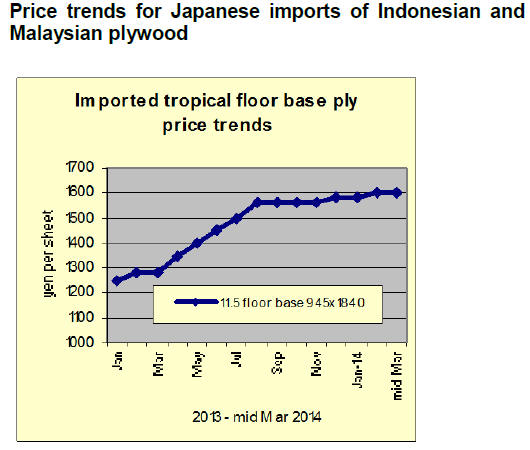
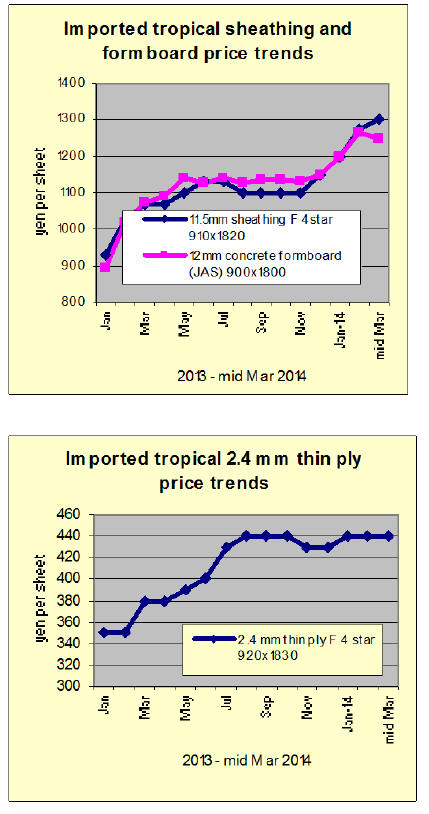
Trends in office, kitchen and bedroom furniture
imports
Japan‟s office kitchen and bedroom furniture imports from
2009 to the end of January 2014 are shown below. Imports
of bedroom furniture exhibited a cyclical trend between
2009 and 2012. However, from 2012 bedroom furniture
imports began to increase and have continued upwards
since. January 2014 imports marked a new high for
monthly imports of bedroom furniture.
January imports of office and kitchen furniture expanded
sharply a reflection of the firm housing market and the
desire on the part of businesses and the public to purchase
furniture before the consumption tax is raised in April.
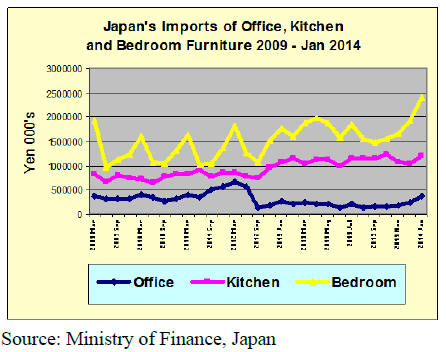
Office furniture imports (HS 9403.30)
January 2014 office furniture imports into Japan were
around 40% higher than for the same month in 2013 and
sharply up on December 2013 imports. The top suppliers
of office furniture to Japan during January were China
(53%) Poland (12%) and Portugal (7%) accounting for
some 72% of all office furniture imports.
If imports from Malaysia and Indonesia are added to the
imports from China then Asian suppliers accounted for
close to 60% of Japan‟s January 2014 office furniture
imports with the balance coming from EU suppliers.
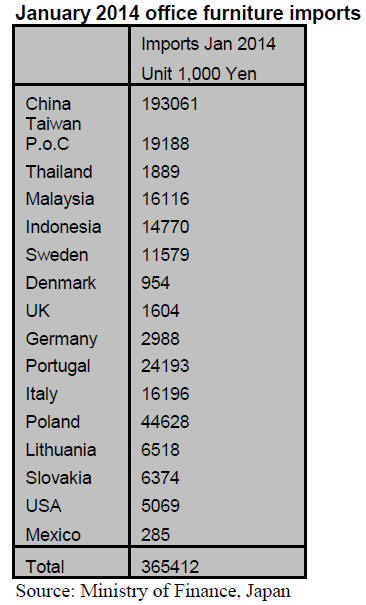
Kitchen furniture imports (HS 9403.40)
Imports of kitchen furniture in January 2014 were one of
the highest since 2009. January 2014 kitchen furniture
imports were 13% higher than in January 2013 and 17%
higher than in December 2013. Vietnam (37%), China
(26%) and Philippines (16%) accounted for the bulk of the
kitchen furniture imports in January 2014.
If imports from Thailand and Indonesia are included in the
sub total above then Asian suppliers accounted for over
90% of Japan‟s kitchen furniture imports.
Of the non-Asian suppliers Germany and the US were in
the top 20 suppliers but could together only secure a
modest 5% market share.

Bedroom furniture imports (HS 9403.50)
Japan‟s imports of bedroom furniture steadily increased
throughout 2013 and there was a surge in imports in
January 2014 lifting the monthly value of imports to a new
record high.
Compared to imports in January a year early, 2014
January imports were up 36.5% and compared to imports
in the previous month of December, imports rose 24%.

While China maintained its number one ranking in terms
of the value of imports, newcomer suppliers, namely Hong
Kong and Singapore, provided a large proportion of
January 2014 bedroom furniture imports.
Together, China Hong Kong and Singapore accounted for
89.5% of Japan‟s January 2014 imports of bedroom
furniture.The top non Asia suppliers were Poland, the US
and Romania.
|